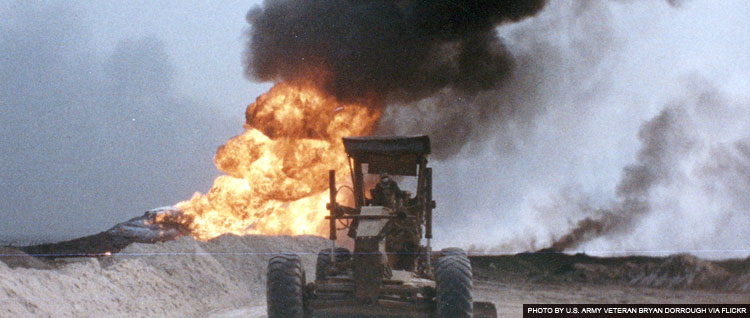
U.S. soldiers were exposed to clouds of soot, liquid, aerosols and gases when Iraqi armed forces set fire to oil wells during the Gulf War in 1991.
Gulf War Syndrome compensation may be available to veterans. Gulf War Syndrome (GWS), also known as Gulf War Illness (GWI), is a chronic multisymptom illness affecting a wide cross-section of Gulf War-era veterans who fought in the deserts of Iraq and Kuwait.
What are some of these illnesses? Among the current recognized acute and chronic conditions include:
• Chronic Fatigue Syndrome
• Fibromyalgia
• Functional gastrointestinal disorders, including irritable bowel syndrome (IBS), dyspepsia, and abdominal pain syndrome
• Abnormal weight loss
• Undiagnosed illnesses with symptoms that include fatigue, cardiovascular disease, muscle and joint pain, headache, menstrual disorders, neurological and psychological problems, skin conditions, respiratory disorders, and sleep disturbances.
Did you know …
The VA does not use the term “Gulf War Syndrome” when referring to the conditions of veterans of that era. The agency and U.S. law (38 USC 1117 and 38 USC 1118) refer to Gulf War Syndrome as “medically unexplained illnesses”, “chronic multisymptom illness”, and “undiagnosed illness.”
Did you know …
That U.S. law (38 USC 1118) provides that veterans who were on active duty in the Persian Gulf and has experienced or is experiencing any of the mentioned illnesses or conditions, a presumption of exposure to a “biological, chemical, or other toxic agent, environmental or wartime hazard, or preventative medicine or vaccine” exists. These agents and vaccines were used by U.S. Armed Forces during the conduct of the campaigns. That means Gulf War Syndrome compensation is available to veterans of that era.
Many causes of Gulf War Syndrome have been proposed and studied over the past two decades, including active duty exposure to depleted uranium, sarin gas, smoke from burning oil wells, anti-nerve agent and anthrax vaccines, deployment stress, and psychological factors.
In response to reports by Gulf War veterans following the end of the Gulf War in 1991 experiencing multiple symptoms of enduring chronic conditions, Congress mandated in 1998 that the National Academies of Science Institute of Medicine produce nine comprehensive reports looking at all potential factors. Those nine volumes of reports can be downloaded below.
Did you know …
Soldiers may have had to endure myriad exposures in the Persian Gulf between Aug. 2, 1990 and March 3, 1991 during operations Desert Storm and Desert Shield, including:
• A series of vaccinations: yellow fever, typhoid, cholera, hepatitis B, meningitis, whooping cough, polio, tetanus; and some troops anthrax and botulinum toxoid
• Taking the anti-nerve agent pill pyridostigmine bromide as a pretreatment against potential attack by nerve agent soman
• Breathing toxic clouds of soot, liquid, aerosols and gases in the smoke from oil well fires set by Iraqi troops
• Use of pesticides like lindane (to treat uniforms) and DEET (on the skin) as personal insect repellants among other pesticides used in the region
• Destruction by U.S. forces and release into the atmosphere rockets filled with sarin and cyclosporine mixes at a munitions storage depot in Iraq following the 1991 cease-fire
• Sand, dust, pollution and other airborne particles inhaled by U.S. troops, including microscopic particles and droplets that included acids, chemicals, metals, and soil
• Use of depleted uranium (DU) in tank armor and bullets; this depleted uranium has 40 percent less radioactivity but the same chemical toxicity as natural uranium
• Toxic embedded fragments, or shrapnel, in soldiers’ bodies and injuries from improvised explosive devices (IEDs), bombs, mines, and shells. Some fragments may contain depleted uranium
• Infectious diseases: Malaria, Brucellosis, Campylobacter Jejuni, Coxiella Burnetii (Q fever), Mycobacterium Tuberculosis, Nontyphoid Salmonella, Shigella, Visceral Leishmaniasis, and West Nile Virus
• The Chemical Agent Resistant Coating (CARC) paint used on military vehicles designed to make them resistant to corrosion and penetration by chemical agents; breathing during paint-drying process, welding or sanding was harmful
• Heat injuries such as heat stroke, heat exhaustion and severe sunburn
• Occupational hazards through exposure to asbestos, industrial solvents, lead, radiation, fuels, PCBs
• Harmful noise from gunfire, explosives, heavy rockets, jets and aircraft, and machinery.
In response to early reports by Gulf War veterans experiencing multiple symptoms of enduring chronic conditions, Congress mandated in 1998 that the National Academies of Science Institute of Medicine produce nine comprehensive reports looking at all potential factors. Those nine volumes of reports can be downloaded below.
Did you know …
Despite the urging of Congress, the VA rejected any link between brain cancer, lung cancer and migranes to Gulf War Syndrome, therefore making them presumptive conditions for Gulf War Syndrome compensation. VA officials said the number of brain cancer deaths for troops exposed to sarin gas was too low to be conclusive, though it was double the rate of troops not exposed. And the rate of lung cancer deaths, though 15 percent higher than those who did not serve in the 1991 Gulf War, is “inconclusive” because researchers did not know how many of the servicemembers smoke.
Did you know …
When the U.S. bombed munitions factories in Iraq in 1991, a plume of sarin gas was released and traveled more than 300 miles to affect U.S. troops in Saudi Arabia waiting for the ground offensive to begin.
Did you know …
A report out in 2013 by the Institute of Medicine said that Iraq and Afghanistan veterans may be suffering from the 20-year-old set of symptoms for Gulf War Syndrome. “Preliminary data suggest that [chronic multisymptom illness] is occurring in veterans of the Iraq and Afghanistan wars as well,” the report says. Currently there is no presumption of these conditions being connected to recent veterans, a situation that bears watching in the near future.
Did you know …
Currently, the VA says exposure to burn pits during service “does not show evidence of long-term health problems.” However, veterans may submit a claim for health problems they believe are related to exposure to burn pits. The VA decides these claims on a case-by-case basis, and the burden of proof lies with the veteran to make the service connection. Also, be sure you have signed up on the VA’s Airborne Hazards and Open Burn Pit registry to document your exposure, schedule an exam, and learn about follow-up care.
Be sure you’re receiving the treatment and care you need, of if you know someone who served in the Gulf War or in Iraq and Afghanistan, make sure they’re aware that Gulf War Syndrome compensation and healthcare benefits are available. Also, dependents and survivors may be eligible to receive benefits.


